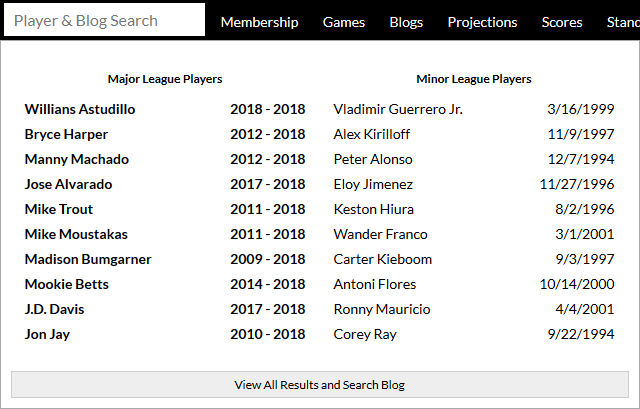Below is an analysis of the prospects in the farm system of the World Series Champion Boston Red Sox. Scouting reports are compiled with information provided by industry sources as well as from our own (both Eric Longenhagen’s and Kiley McDaniel’s) observations. For more information on the 20-80 scouting scale by which all of our prospect content is governed you can click here. For further explanation of the merits and drawbacks of Future Value, read this.
All of the numbered prospects here also appear on The Board, a new feature at the site that offers sortable scouting information for every organization. That can be found here.
Other Prospects of Note
Grouped by type and listed in order of preference within each category.
Upper-level Hitters
Brett Netzer, 2B
Josh Ockimey, 1B
Roldani Baldwin, C
Netzer is a Tommy LaStella type: fine at second base, an advanced hit tool with a little bit of power, and probably just a good bench bat. Ockimey shows plus power and patience at the plate, but the average will be low and he’s a 30 athlete who some scouts think is a DH-only, so it’s going to be tough to profile. Baldwin has some pop, but isn’t a lock to catch and he’s had injury issues, including a concussion.
Lower-level Hitters
Kole Cottam, C
Cedanne Rafeala, OF
Tyler Dearden, OF
Bryan Gonzalez, RF
Albert Feliz, OF
Eduardo Vaughan, CF
Cottam, 21, is either short on arm strength or defensive ability behind the plate (maybe both) depending on who you ask, but he has plus power and hit 19 homers for Kentucky last year, so there’s some Mike Napoli type upside if it all works out. Rafaela, 18, is a Curacao-born Ronald Torreyes-type, about 5-foot-8 and a multi-positional plus runner with bat control and sneaky tools. If we’re talking upside, one scout said Dearden, 20, could be Cody Bellinger if it all goes perfectly, with a similar frame and swing, but he’s a raw cold-weather player who hasn’t reached Low-A yet, so he’s a wait-and-see case. Gonzalez and Feliz are 2018 July 2 signees. Both have plus raw power and strong frames now, but Gonzalez has the arm for right and a little better feel to hit at the moment. Vaughan is a very raw projection type with some average current tools, but he’s the sort who could take a big step forward.
Relevant Pitching Depth
Chandler Shepherd, RHP
Josh Taylor, LHP
Colten Brewer, RHP
Brewer was acquired for Esteban Quiroz this winter and relies heavily on a 92-94 mph plus cutter, mixing in a solid curveball. He put up great numbers in Triple-A and might be a middle relief piece. Shepherd is an inventory arm with a standout curveball who’s likely a long reliever in the big leagues. Taylor was acquired from Arizona for Deven Marrero and has a big arm that’s been into the upper-90’s, but the rest comes and goes. He was added to the 40-man this offseason.
Lower-level arms
Alexander Montero, RHP
Thad Ward, RHP
Also Ramirez, RHP
Jake Thompson, RHP
Thompson looked like a real prospect after going in the fourth round in 2017 from Oregon State, hitting 98 mph with a starter look in his pro debut, but everything backed up this year. He’s still throwing pretty hard but hasn’t performed. Ramirez is a 17-year-old Mexican pitcher who would’ve gone to the GCL last summer if not for fatigue; he has advanced feel of a four pitch mix and looks like a potential starter. Ward had a velo jump at UCF this spring, going from 88-91 to 91-95, touching 96 mph, but was used heavily and regressed in his pro debut. There’s a slider that is a consistent 55 and flashes 60, and solid command that should allow him to start for a bit in pro ball, but his skinny frame will likely limit him to relief.
System Overview
This system is bad, though it got that way in part because talent from it was used to build a championship team, which is the very best of reasons to have a bad farm system. Still, this group is more compelling than the one we wrote up last year now that the 2017 IFA group has already had several members who have asserted themselves as the system’s most interesting players to follow. The Red Sox have a strong recent track record in Latin America. Former International Director Eddie Romero was promoted to Assistant GM while former Mets International Director Chris Becerra, who signed several of the Mets’ prospects near the top of our recent audit of that org, was brought in to replace him. The Red Sox domestic talent acquisition is going to be limited as long as they’re fielding a good big league team, but we expect the international talent to keep flowing.


